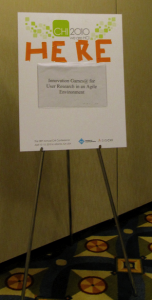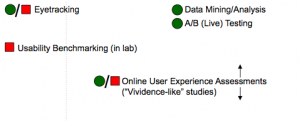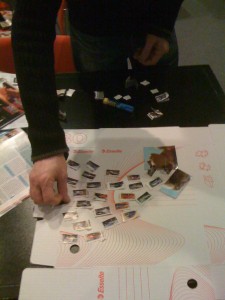
Poster announcing Course 27 at CHI2010
What can you do in 90 minutes to introduce a professional audience to the set of practices which are Innovation Games®? Quite a bit!  But not all of what we had planned.
The course announcement
Here’s what people saw on the web when they considered whether to enroll in this course “Innovation Games® for User Research in an Agile Environment”, which competed against about 10 other sessions in the same time slot.
This course describes a set of qualitative research methods that will be attractive to user researchers, customer satisfaction specialists, Chief Happiness Officers, marketing professionals, among others. People who participate on Agile teams and those who are considering making a change to Agile practices will enjoy learning new techniques that fit into an Agile framework. Designers, engineers, and others with limited research background are welcome to join in the fun. (more…)
Tags: chi, chi2010, conference, course, design games, fun, Innovation Games®, observers, training, User Experience, ux
 User researchers know that it’s possible to analyze qualitative responses with quantitative methods, given enough responses.
User researchers know that it’s possible to analyze qualitative responses with quantitative methods, given enough responses.
Research methods are divided into various categories. One familiar distinction is the qualitative and quantitative. Sometimes we think of these categories as distinct types of research: Â either-or. A research project collects qualitative data (e.g., an interview with questions that invite open-ended responses) or quantitative data (e.g., a survey with multiple-choice, true-false, or scalar responses). Or is it that the analysis uses qualitative methods (affinity diagrams) or quantitative methods (statistical packages)? (more…)
My spoken French is more or less limited to menu items and courtesy phrases. Â I’m better at comprehension, but unable to express myself to my own satisfaction in a business setting. Â One of the challenges of the managing the tutorial at WIF 2008, was that this session was held in Limoges, France.
As a tutorial leader, I might have been out of luck, but I was ably assisted by two professional interpreters.  In a room of about 35 people, I estimate that there were 6-8 French speakers; the remainder were willing to work in English.  Among them were native speakers of perhaps 4-5 additional languages, but English was the lingua franca for most.
After a brief introduction about design games in the product development process, and Innovation Games® in particular, we broke into groups to create “Product Boxes.”  I said, but perhaps not forcefully enough, that people could work alone or in small groups.  When Product Box starts, people dig into the materials and start making their sketches and notes.  They probably weren’t paying close attention to me (nor, in this case, the interpreter).
In the midst of the game play one participant approached me through the interpreter, identifying himself as a game designer. Â He announced that “teams are the enemy of freedom.” Â Either this was very deep and philosophical statement, or there was a simpler interpretation that I was overlooking. Â Asking for clarification, I realized that he didn’t want to work with the people he happened to share a table and language community with: Â he wanted to create on his own.
I encouraged him to go ahead and work solo. Â Although this exchange prevented him from completing the full design he had envisioned, he did realize at least one good idea as shown in this photo

- ideas filling or spilling from head
The ideas fly freely (into?) out of the head!
Are teams the enemy of freedom? Â I might agree that teams constrain individual freedom, but I’m also a subscriber to the aphorism “many hands make light work” (there must be French for this one!). Â There’s more to say about games as focused toward individuals, groups or teams, but I’ll save that for another occasion.


